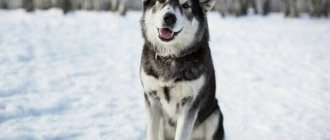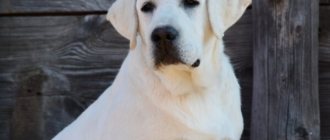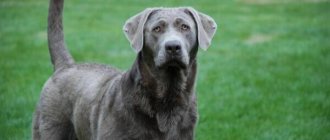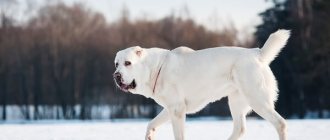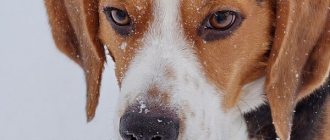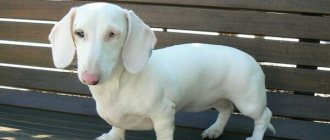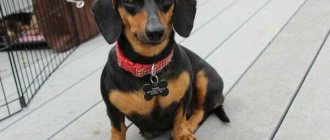The White Malamute is an amazingly beautiful dog with a strong and proportional build.
This stately and strong animal seems to be the very embodiment of harsh Alaska with its snowfalls and lakes covered with ice.
Due to their color, white malamutes resemble polar white wolves or Samoyed huskies.
And although they are no different in character and working qualities from other representatives of their breed, when keeping them in the house you need to take into account some nuances.
Origin story and what it looks like in the photo
The ancestors of Malamutes appeared in Alaska from 4500 to 1000 years ago, moving from Siberia along with the tribes of ancient Eskimos.
These dogs got their name from the name of the Malmut tribe, whose faithful companions and helpers they were for centuries.
Strong and resilient dogs have long helped the ancient inhabitants of Alaska by hunting wild animals and transporting cargo on special carts or boats.
In those days, people were exclusively interested in the physical strength, endurance and working qualities of dogs, and therefore, the owners of the first Malamutes did not pay special attention to the color of their pets.
And, apparently, the first of the white Malamutes appeared already in ancient times.
Subsequently, when the breed was officially recognized in 1935 and a standard , white became the only solid coat color allowed for Malamutes .
By the mid-20th century, the number of these dogs had declined greatly: after World War II, only about 30 purebred Malamutes remained alive.
The restoration of the breed began in the post-war period, in 1947, and by the early 1960s, Malamutes were no longer in danger of extinction. And about 10 years later, in the 1970s, their popularization and distribution throughout the world began.
A 2015 genetic study showed that the Alaskan Malamute is a breed related to the Siberian and Alaskan huskies and that the ancestors of all three of these breeds are the ancient Chukchi sled dogs .
Malamutes, including white ones, played a huge role not only in the development of northern lands in America, but also in the exploration of the Arctic and Antarctic.
These dogs were used as sled dogs during Richard Byrd's expedition to the South Pole and as search and rescue dogs during World War II.
Nowadays, Malamutes have become a popular show and sporting dog, and, of course, they make wonderful pets..
Historical reference
Alaskan Malamutes are considered one of the oldest sled dogs; the exact date of origin of the breed is unknown. Most experts believe that it was bred by the Eskimo tribe, who were located in northern Alaska. Dogs were used to pull sleds and hunt. Malamutes began to be in great demand at the beginning of the 20th century during the “gold rush”. But such popularity had a negative impact on the breed - many gold seekers tried to get even more hardy animals by crossing Alaskan representatives with other dogs. The pure population was only expanded in 1926. The first standard was adopted in 1935 by the American Kennel Club, but recognition by the Fédération Cynologique Internationale occurred in 1963. Today the 1999 edition is considered valid.
Malamutes are used for harness work
Marriage or breed?
The white color of Malamutes is considered standard and is not a defect in the breed.
Expert opinion
Kozhevin Semyon Kirillovich
Expert dog handler.
“The White Malamute is a dog of compact build, distinguished by snow-white thick, fluffy, two-layer, not too long hair. At the same time, the hair coat of Malamutes in the summer is shorter than in winter and less dense. By nature, these are friendly and active dogs, which, despite their impressive appearance, are too good-natured to become reliable watchdogs. White Malamutes are quite silent, they are one of those few dogs that hardly bark, but are capable of making grumbling sounds of various tones, so that from the outside it may even seem that the pet is talking to its owner in this way.”
Nutrition
When composing an animal’s diet, one should take into account the fact that overeating negatively affects the dog’s health. You should also take into account the fact that Malamutes can steal food if left unattended.
Despite the fact that this breed is powerful and strong, its diet should not be excessive, but optimal, even if we take into account that it leads a fairly active lifestyle. Until 4 months of age, puppies are fed 4 times a day, and after that they switch to 2 meals a day. At the same time, you also need to take into account that this dog may experience intestinal volvulus if you give a lot of food at one time.
Character traits
White Malamutes are distinguished by their quick wit and high intelligence, without which they simply would not be able to survive in the harsh climatic conditions of the Far North.
These dogs are loyal to their owners and usually obey them . But, since Malamutes are quite large and strong dogs, sometimes showing stubbornness, such a pet needs early education and proper training.
Due to its large stature and powerful build, the white Malamute can look impressive, however, these dogs are not characterized by aggressiveness towards people, and therefore they make unimportant watchmen.
But white Malamutes, distinguished by their good-natured and sweet disposition, are often used for animal therapy.
They treat children kindly, and this is not surprising: after all, Eskimo tribes have long used them to look after children.
However, we must remember that even the most good-natured dogs do not like to be teased or pulled by the ears and tail, and therefore, children from an early age should understand that they should treat their pet kindly and with respect.
Because white Malamutes have been used as hunting dogs for centuries, they have a very strong instinct to pursue potential prey..
It is necessary from an early age to accustom your pet to the correct attitude towards small dogs, cats, birds and other small pets.
Kinds
Alaskan Malamute breed types
Breeders standardized 2 types of breed - Kotzebue and M-lut. Each of them has a number of distinctive features. For example, the first one is less powerful and hardy. But such dogs are much kinder, and they also have well-developed sociable abilities. If we talk about m-loot, it is worth noting that this dog is capable of aggression. It is larger, has amazing endurance and strength. Modern breeders often argue as to which of these types of Malamute is more correct. Most families prefer the Kotzebue, considering it a good, big guy. But there are husky lovers who need to protect their territory. M-loot is more suitable for them.
Advantages and disadvantages
pros:
- He is distinguished by his quick wit and high intelligence.
- Strong and resilient.
- Looks impressive.
- It is clean and has almost no specific smell.
- Friendly to people.
- Loyal and affectionate.
- Treats children well.
Minuses:
- Quite aggressive towards small dogs, and in a pack he tries to take the position of leader.
- He does not have a developed protective instinct and is too good-natured, therefore, he is not suitable for the role of a watchman.
- Severe shedding.
- Needs a lot of physical activity and regular training.
If desired, a white Malamute can be trained to carry loads and participate in sports competitions in this discipline..
Dimensions, weight and other distinctive features
| Options | Data |
| Height | For males it is 60-63 cm, for females it is 57-59 cm. |
| Weight | Males - 38-40 kg, females - 34-35 kg. |
| Format | Rectangular, tending to square: the length of the body should exceed the height at the withers by 1-2 cm. |
| Head | Wide, powerful, slightly rounded with a shallow transition to a moderately voluminous muzzle. |
| Ears | Standing, triangular, medium in size and proportional. |
| Eyes | Brown, medium-sized, slightly slanted. |
| Nose | Black is desirable, but it is considered acceptable to have lighter veins on the dog’s nose. |
| Neck | Strong, slightly curved. |
| Back | Straight and level. |
| Rib cage | Developed, moderately wide |
| Limbs | Parallel, strong and muscular. |
| Tail | Well-furred, of medium length, carried raised above the back in the form of a plume. |
| Wool | Two-layer, consists of a rather soft undercoat and a thick and rough outer coat. The length of the hair varies from short on the head and front of the legs to moderately long on the neck, tail and hind legs. |
The movements of a white Malamute should be calm and unfussy, but at the same time they should feel strong and powerful.
Wool shades
- Black and white . The main color is black. There are blurred white spots on the face, neck, chest, belly, limbs and tail.
- Gray-white . The main background is greyish, from light to almost black, with white markings with not very clear outlines.
- Reddish-white . On a tan or sable base, there are white markings located on the head, neck, chest, belly, paws and tail.
- White . With this coat color, pure white is considered the most preferred shade.
Any of the two-tone colors should be similar to the raincoat.
Uneven or interrupted coat color along the body should be considered a serious fault.
Life expectancy and what diseases are they susceptible to?
On average, white Malamutes live 13-16 years.
At the same time, they may be susceptible to the following ailments:
- Progressive retinal atrophy.
- Hip dysplasia.
- Volvulus of the stomach or intestines.
- Cataract.
- Epilepsy.
- Congenital pathologies of the heart and kidneys.
- Skin diseases such as dermatitis and eczema.
CAREFULLY!
Alaskan Malamutes, like other northern dog breeds, have a predisposition to developing diabetes, the first signs of which can develop as early as 5-7 years of the pet’s life.
What is the color and color of Alaskan Malamute dogs?
The visible pigment of the outer part of the hair. A significant number of dogs, along with pigmented hair, have white spots or marks in certain areas of the body that are devoid of pigment, i.e. hair lacking pigment. When mixing colors, the color of the dog is determined by the dominant color. A dog has such types of hair as downy, integumentary (smooth), guard hair. The different properties of wool are determined as an adaptation to different climatic conditions and their habitat. Each type of coat and its color requires special care. Breeders have studied how color and patterns are created on the body of an animal. Genes can be responsible for hair structure and color. This is general information that applies to all dog breeds and does not apply to Alaskan Malamute puppies.
- A. With the help of this locus, a solid color of the pet’s entire body is obtained (monochromatic).
- B. Dyes wool black. Some species have partial of this gene (spotting). Some dog breeds necessarily have this gene!
- C. This is the key component! With its help, the body produces color throughout the body. If this component is missing, the dog may be born without color (albino). The color of the nose and iris does not depend on this component.
- D. If there is little gene in the pet’s body, then the coat will be lighter. If there is a lot of gene in the body, then the dog will have a rich black color. The gene affects the viability of the dog; if a pet is born with a lack of the gene and a blue color, then he may most likely not live to see his senior years. When the gene is dominant, the color of the pet turns out to be black.
- G. With old age, this component is activated and gray hair appears. They call him gray-haired. When the color turns gray.
- E. With its help, in most cases, three-color colors are obtained, containing pigment of black, brown and yellow.
- M. The gene leads to anomalies for the pet and gives a harlequin pattern. Has a marble color. With old age, the gene can lead to lightening of color.
- S. This gene causes partial body pigmentation in dogs. (white spotting).
- T. The gene is characterized by mottling. It is opposite to the S gene and forms dark spots on white areas.
- R. Chastity - alternation of hair that is colored and not.
Basic rules of care
The coat of the White Alaskan Malamute is not prone to matting or getting dirty quickly. Therefore, in normal times it is enough to brush your pet once a week. It should be bathed as needed, but not more than 2-3 times a year.
Eyes, ears and claws usually do not require special care, but they should be carefully examined after every walk and in the morning..
In case of contamination, ears should be cleaned with a cotton swab, eyes should be wiped with a cotton swab or a soft cloth with a special composition applied to them.
Malamutes' nails rarely require grooming, but if they do not wear down, they should be trimmed with a nail clipper for large dogs.
To clean your dog's teeth, you can give your dog chewing cartilage or special treats purchased at a pet pharmacy..
If the pet eats soft food, then its teeth must be cleaned additionally using a toothbrush for dogs and a special toothpaste.
If your white malamute develops tartar, it is recommended to consult a veterinarian..
Health
Health of the Alaskan Malamute breed
There is only one health study of this breed, conducted by the UK Kennel Club in 2004 on a small group of 14 dogs. The average lifespan of an Alaskan Malamute is 10.7 years, which is comparable to other breeds of the same size. However, the sample is too small to be considered reliable and other sources say that the Malamute has one of the longest life expectancies for large dogs - up to 15 years.
However, the sample is too small to be considered reliable and other sources say that the Malamute has one of the longest life expectancies for large dogs - up to 15 years.
How to choose?
First you need to decide on the gender of the puppy.
Males are stronger and more robust, they look more impressive and are more suitable for an exhibition or sports career.
Bitches, having a calmer and gentler disposition, are preferable as a pet, especially if there are children in the house.
Next, you need to move on to finding a suitable breeder or nursery . And, of course, you should not purchase a white Malamute without documents, since only the metric is confirmation of the purebred origin of the puppy.
When going for a future pet, you definitely need to talk to the breeder and look not only at the puppies themselves, but also at their parents. If there is something alarming about the appearance or behavior of adult dogs, then it is better to refuse to buy a baby from this kennel.
The puppy itself should look healthy and active, it should have thick and well-groomed fur, clean ears and skin and shiny dark eyes..
The baby should be playful and friendly towards people, as well as towards the dogs living in the kennel.
IMPORTANT!
Together with the puppy, the owner must give the buyer a birth certificate and an international veterinary passport, and also advise the new owner on what to feed and how to properly care for the pet.
